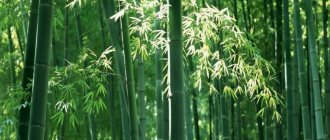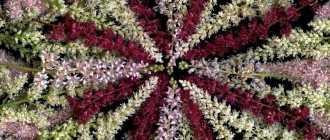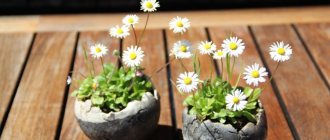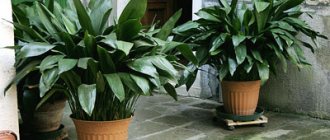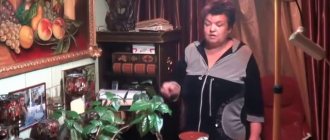Episcia belongs to the Gesneriaceae family, which is widely represented in indoor floriculture. The name of the genus Episcia comes from the Greek “episkios” - dark, shaded, it contains from 30 to 40 species of plants. In English sources, the epics are called: “Flame Violet”, which means “Purple Flame”, “Peacock Plant” (Peacock Flower), “Chameleon Plant” (Chameleon Plant) or “Orange african violet”.
The homeland of Episcia is the tropical forests of Brazil, Mexico, Colombia, Guinea, Suriname and the Antilles. In nature, they grow as low, creeping herbs with many lateral shoots in shady, moist places under trees.
Description
Episcia is valued for its foliage. It comes in a variety of colors: emerald, jade, bronze, copper, silver. The greenery shimmers with mother-of-pearl. In many species, a pattern is observed along the central region of the leaf.
Leaf plates have different shapes: round, oval, elliptical. Their surface can be smooth with shine or pubescent, similar to velvet. The edges are smooth and jagged.
A bell-shaped inflorescence on a short stalk with 5 petals. Blooms in July-September. The formation of fiery red buds occurs in single quantities or in bouquets. It has creeping shoots and tendrils, like strawberries. Thanks to them, the plant reproduces.
Bloom
The crop blooms for a long time - from early spring to late autumn. The flowers are not large, axillary, gramophone-shaped. Their dimensions are 2x3 cm. The buds are bright: white, yellow, purple, speckled. Each has 4 single tubular stamens. Delicate flowers combine beautifully with lush foliage of different colors.
Episcia flower - types and varieties of indoor plants
After flowering, a period of rest begins. Fertilizers and watering are reduced. When there is not enough daylight, they are illuminated with lamps.
Note! Episcia is a perennial evergreen plant. It does not lose its decorative properties in winter and serves as a wonderful home decoration.
Domestic species
Not every plant variety was able to change its wild habitat to indoor conditions. Episcia has the following varieties that can be grown at home:
| Variety | Description |
| Copper. | Large view. With an oval plate that widens at the base. Brown-greenish foliage with a red tint turning into a copper color, velvety. A white vein is observed along the central zone of the leaf, creating contrast. The lower zone of the plate is reddish. The arrow on it is bright green. The greenery shimmers in the sunlight. The inflorescence is bright scarlet or fiery. The beginning of the petals is yellowish. Flowering is observed all summer. |
| Carnation flower. | Some experts classify this variety as a separate genus Alsobia. Like all species, it has antennae with daughter rosettes, short shoots, densely dotted with small leaves at the ends. The plate is dark green, almost black. There is a purple vein running down the middle. The flowers are white with red freckles at the base. The edge of their petals is fringed. |
| Creeping. | The name is due to its strong branching, forming a dense network of shoots. The variety has small leaves (length 9 cm, width 4-5 cm). The plate is olive-colored from the upper region, dull red below, covered with villi. The leaf shape is heart-shaped. Peduncles are purple. The petals are crimson on the inside, bloody on the outside. Flowering is observed from July to September. |
| Chocolate soldier. | Has thickened leaves. A network of veins is observed on the plates, making them voluminous and embossed. The foliage is green-purple. Flowering lasts for a long time. |
| Forest beauty. | The foliage has a silver-lavender hue with a bluish tint. Pastel pink flowers are observed in single quantities. They are small in size. |
| Northern lights. | The leaves have a unique combination of lilac-gold and dark green with a brown tint. The plates are pubescent, with cross veins. The petals are bright scarlet. |
| Silver glow. | The leaves are elongated, oval with pointed ends. Greens of a soft light green tone with a silvery mound. Rare flowers of a scarlet hue are observed between the leaves. |
| Blue Nile. | It is quite rare. Produces heavenly flowers with a lavender tint. Their middle is yellow. The foliage is brown-green with fluff. In the middle there is an olive-greenish stripe with middle veins. |
| Silver skies. | The rusty-red inflorescences contrast strongly against the background of silvery foliage. |
| Pink Panther. | Does not require special care, grows to large sizes. The flowers are large, bright strawberry. The foliage is green with a limestone, bronze tint. The plates can reach fifteen centimeters. |
| Pink akazhu. | The leaves are silver-green with snow-green stitches and splashes of pink. It blooms with reddish-red inflorescences with a yellowish core. |
| Tiger stripe. | Similar to tiger epic. A distinctive feature is the fine greenery with silvery veins. |
| Strawberry patch. | It has small leaves with pointed ends. The greens are bright, pinkish-red in tone. Scarlet buds with a lemon base. |
| Chocolate cream. | Silvery brown green with pinkish lines. The inflorescences are red. |
| Ronnie. | The buds are coral, the leaves are brown with silver-green veins. |
| Degas. | The leaves are brown-green with lines. The inflorescences are large and red. |
| Aloha Mauna Loa. | It is distinguished by quilted leaves similar to dark green velor. Reddish-red flowers. It is a hybrid bred specifically for home use. |
| Dutch. | The leaves are dark brown, velvety, medium in size. The light green, silvery pearlescent veins have a herringbone pattern. The inflorescence is red with a pinkish tint. |
Watercolor varieties are also bred at home. They are distinguished by an unusual foliage color and are not found in natural conditions. The following species are in demand among gardeners: Danae, Inessa, Black Queen, Strawberry mist (Strawberry mist) and Strawberry patch, Safari, TM-Sahara, Tiger stripe, Tricolor, Brown beauty, Panama white, Lilacina viridis, Sun Gold (Chimera), Dixie Dynamite, Smoky Topaz, Country Kitten, Coco, Gray Lady, Longwood, Sea Foam, Neptune, Silver Tire, Miniature Symphony (symphony), Seduction, Sports, Suomi, Helen Dixie.
Home care
Epistomy care at home should be carried out according to all the rules:
| Factor | Recommendations |
| Location | Location matters when growing. It is recommended to place the pot on a windowsill on the north side. If this is done from the south, the plant moves a couple of meters from the window. When placing a flowerpot from the west or east, it is hung on the left or right side of the window sill. |
| Lighting | The light should be diffused. The plant does not like direct sunlight. In winter, additional lighting is needed to extend daylight hours by several hours. |
| Humidity | The minimum humidity level is 60%. To increase it, it is recommended to place containers with aqueous solutions or moss, expanded clay, coconut fiber, peat near the episcia, moistening them. If this is not enough, then the pot with the plant can be moved to the kitchen (there the air humidity is higher). Perform spraying and wiping. |
| Temperature | Episcia does not have a rest period. Feels comfortable at +22° to +26°C. In winter, the temperature can be lowered to +18°C. At +16° the flower dies. At +30° or more it will survive, but with proper watering. |
Pot, soil, replanting
The rhizomes of the flower are thin and fragile. They creep close to the ground surface. Therefore, for planting you need to choose a shallow pot or a wide bowl. The plant is planted in groups (three or more).
When growing a flower using the “carpet” method, you need to select a large pot so that there is enough space for the tendrils to grow. If planting is done in a hanging pot, then the container can be taken smaller: the mustache will hang down.
The soil is light, with medium acidity. The soil consists of leaf soil, peat and sand (3:1:1). Sphagnum and ash are added. Drainage is required: the bottom is lined with expanded clay or polystyrene foam (layer three centimeters).
The plant grows quickly; it is replanted once every twelve months. This happens as follows:
- episcia is watered and carefully removed from the pot;
- the root is inspected: dried and rotten areas are removed;
- a drainage layer of 3 cm is laid on the bottom, soil is poured on top;
- planting and watering are carried out.
The circumference of the pot for replanting should not exceed 20 cm.
Epission: signs and superstitions
Popular rumor advises giving this flower to those who have not yet met their love. It brings joy to everyone and is useful to those who despair in life. It lifts your spirits, instills hope and love of life. The giver can also meet his love.
Despite the fact that the flower plant is not a medicinal plant, the aura emanating from the flower enhances vital activity, fills with positive energy and helps to find a common language with different people.
Thanks to the influence of the flower, people's creativity and creativity increases, their fighting spirit increases, and the work they do brings much greater satisfaction, therefore it is suitable for absolutely everyone, without exception.
Conclusion
If you like the beautiful Episcia, then don’t delay purchasing her. Episcia will decorate your collection of indoor flowers. Moreover, it is not capricious and does not require any special expenditure of money, time and effort.
The lush bush is beautiful all year round, especially during flowering periods. Easily propagated.
In addition, there is a popular belief that if you give someone an indoor Episcia flower, you yourself will definitely fall in love. Who knows? For the sake of such a wonderful feeling, you can take a risk and breed several specimens of this magnificent flower to use as gifts!
Watering
Abundant watering is necessary from early spring to October, every other day. When watering, it is necessary to take into account the temperature and humidity of the air. In winter, you can carry out the manipulation less often: wait until the soil on top is completely dry. Any water that has drained into the pan must be poured out immediately. Excess moisture will destroy the plant, as will drying out.
The water is taken soft, settled for 2-3 days. Temperature - +28-+30ºС. Tap water is softened with lemon acid.
You need to make sure that the drops do not get on the greens: use a watering can with an elongated spout. Water is poured along the edges of the pots.
Top dressing
During active growth, fertilizing with organic or complex fertilizers for indoor flowers is recommended. They also use fertilizer for decorative foliage and flowering plants. You can buy it in a specialized store.
The dosage is indicated on the fertilizer packaging; it is reduced by 2-2.5 times.
Feeding is done twice a month. There is no need to fertilize the soil in autumn and winter. When the soil is dry, the event cannot be carried out: the roots can be burned.
Transfer
The young culture is replanted once a month. Mature bushes - annually. The dishes are wide but low. Sphagnum and charcoal are added to the soil. Drainage is placed at the bottom.
Episcia dianthus
Before the procedure, the plant is moistened to make it easier to remove it with an earthen lump. If there are several young plants in the pot, separate them. Add new soil and water.
Reproduction
Methods:
- seed;
- daughter sockets;
- side shoots;
- cuttings.
When propagated by seeds, the plant loses its varietal characteristics in 90% of cases. Planting is done in January or June in the surface layer of the earth, without sprinkling. Seeds require greenhouse conditions of +20ºС. The first shoots appear after 10-14 days. After a month they can be transplanted into separate containers.
When propagated by rosettes, without separating them from the adult episcia, they are buried in the soil and rooted. After this, the flower is placed in a new flowerpot or planted next to the mother plant. The roots appear after a week.
Carefully cut cuttings, pre-treated with Kornevin, are planted in previously prepared soil. Covered with glass. Within a few days the cuttings will take root.
Developed tendrils are cut from the mother plant. Each is divided into three parts and rooted in water. Next comes disembarkation.
Correct bush formation
The bush must be trimmed periodically, otherwise it will look sloppy. Overgrown shoots must be removed. When hanging over the edge, the stems will fray. If you want to leave them, you need to attach a grill nearby. Attach shoots to it as they grow.
Episcia propagation on a windowsill
Plant propagation is possible in several ways:
- vegetatively (cuttings, shoots, leaves);
- seeds.
It is better to use the vegetative method. It preserves the characteristics of the variety.
Vegetative propagation of Episcia
The cutting can be a shoot that has 3-4 nodules, but no lateral shoots. It is planted in water (before roots form) or directly into the ground. In the latter case, cover with film.
Possible problems
When care errors occur, problems arise:
| Problem | What is the reason and how to eliminate it? |
| Brown spots of irregular shape form on greenery. | When watering, too cold water is used. It must be warmed up before the procedure. |
| The greenery turns yellow and falls off. | There is an excessive amount of nutrients in the soil: you need to fertilize the plant less often. The reason may lie in prolonged exposure to ultraviolet rays or too much watering. |
| The foliage is curled into a tube. | The flower is watered rarely, but abundantly. |
| The ends of the leaves become brown and dry out. | Lack of moisture in the air or ground. |
| The leaves fade, become dull, and become smaller. | The plant lacks light. It must be placed closer to the window or additional lamps must be used. |
| The greens are covered with a pale dirty or gray coating. | The flower does not have enough fresh air: the room needs to be ventilated regularly, or a transplant is necessary. |
| Doesn't bloom. | Episcia is watered very rarely, the soil has time to dry out. It may also be due to an excess of nitrogen in the soil, lack of fertilizer, dry or cold air. |
| Poor flowering, stretching of stems. | The plant does not have enough light. |
Possible growing difficulties
The main danger is root rot. This is when the ground is wet and the plant for some reason looks lethargic. It was poured at low temperatures, low light, or the pot had poor drainage.
When rot develops, cuttings need to be taken from the bush, rooted in water or soil, and a new plant planted. The old soil is thrown away and the pot is boiled.
When there is not enough moisture, the tips of the leaves dry out. If there is little light or too dark, they curl and lose color.
The plant is sometimes attacked by pests: aphids, mealybugs, root nematodes. They are controlled with insecticides.
Diseases, pests
Methods for eliminating diseases and pests:
| Disease | How to recognize? | Prevention and treatment |
| Chervetsy | The plant turns yellow and dries out, a gray coating and lumps similar to cotton wool appear on the leaves. | It is recommended to maintain high humidity in the room: this prevents the pest from multiplying. It is necessary to remove dried leaves. The plant can be treated with cotton wool soaked in soap suds or sprayed with the same liquid. In the store you can buy drugs against parasites: Tanrek, Apache. |
| Nematodes | These are worms that infect the rhizome. The plant grows poorly and its leaves curl. | It is necessary to maintain the required temperature conditions and follow the rules of watering: heat and excess moisture help nematodes to reproduce. To get rid of the parasite, the roots of the plant are immersed in hot water +50ºС. Solutions of Mercaptophos and BI-58 help. When a plant is severely affected, it has to be destroyed and the soil thrown away. |
| Root rot | The roots become soft and the foliage withers. | To prevent the formation of rot, you need to drain excess water in a timely manner and avoid stagnation. When planting and transplanting, it is recommended to use the drug Glyokladin. To get rid of rot, you need to disinfect the pot and available tools. |
| Spider mite | The foliage becomes translucent, fades and dries. The petiole has a cobweb. Beige-yellowish plaques appear at the bottom of the leaf blades. | It is necessary to increase air humidity, perform quartzing twice or thrice a week (especially the lower part of the leaf). To get rid of the parasite, the pot is disinfected; you can buy poison in the store. You can cope with the problem if you keep the plant in a container with onions, horseradish, tobacco or kerosene infusion, wrapped in plastic, for three to four days. The flower is sprinkled with dried black henbane powder. |
| Thrips | Parasites can be seen with the naked eye by shaking the leaves. They are small, dark brown or black. Grayish-brown lines appear on the foliage, looking like scratches. The greens become whitish or silvery. | To avoid illness, the room is ventilated and humidity is maintained. It is recommended to install devices for catching flies next to the pot. Other plants should be placed away from the episcia. To exterminate the pest, purchased poison is used. Onion and garlic infusions are placed nearby. The flower is watered with decoctions of medicinal herbs. |

